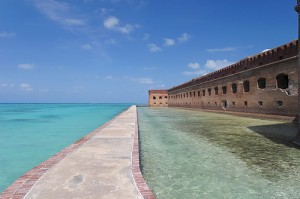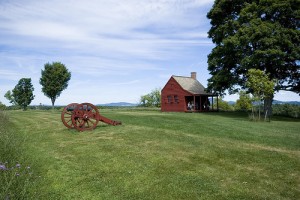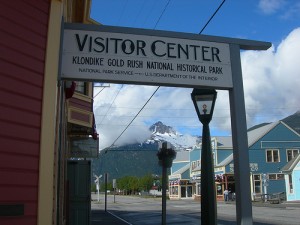Collegial questioning: A new forum on history in the US National Park Service (Part 3)
27 November 2013 – editors
Continued from Part 1 and Part 2.

Fort Jefferson at Dry Tortugas National Park, Key West, Florida. Photo credit: Matthew Paulson.
~ Christine Arato, Chief Historian, National Park Service, Northeast Region
After Imperiled Promise landed with something of a magnificent thud almost two years ago, I liken the NPS response to a progression along the five stages of grief articulated by Swiss psychiatrist Elizabeth Kübler-Ross in 1969: denial, anger, bargaining, depression, and finally acceptance. I’m not sure where the agency is as a whole, though I think that our public conversations at Rutgers-Camden earlier this month intimate that some members of the family are striding towards healing and new life. And while I’m not certain if the grieving metaphor is entirely apt—since the Organization of American Historians (OAH) report suggests that the patient was merely moribund—I do think that the OAH’s rather grave prognosis has helped us to introduce some healthy exercise regimens, including the initiatives described by my colleague Lu Ann Jones, both at Rutgers-Camden and again, here, in this virtual forum, which articulate and embody the assertion that history is at the heart of the NPS and, more importantly, is a pillar of civic life.
I think that Seth Bruggeman’s concluding comments provide a neat summary of the challenges that the NPS faces, as well as a point of departure for the conversations that are to unfold in the months ahead as we explore deconstructions of “expertise;” the need for a Service-wide understanding of our institutional history; an imperative to harness the passions of our visitors in the service of the agency; and the positioning of parks as a point of access to collective identities which are “flexible, fluid, and open to critique.” There are, I believe, two key concepts at the core of this clarion call, self-awareness and its corollary, external awareness, and both are vital to the health of—let’s face it—a seemingly moribund history industry, even beyond NPS boundaries. The recent government shutdown highlighted rather flaccid critical capacities and partisan paralysis in American public life. I think that the dearth of history talking heads in these ostensible debates not only underlines the marginalization of historical thinking and, yes, history professionals, but also—and more importantly—underscores the critical need for an expansive and unified community of practice that can both say and show why history matters, particularly in a digital age which fosters visual acuity and dexterity at the expense of critical thinking and long-term memory.
So, here’s our new cheer: “What do we need? A HISTORY MOVEMENT! When do we want it? NOW!”
In parting thoughts, I revisit the grieving metaphor and invoke the venerable wisdom of Monty Python: We’re not dead yet, only resting. And, in the words of First Lady Michelle Obama: LET’S MOVE.
~~~

Saratoga National Historical Park, Stillwater, New York. Photo credit: Selbe B.
~ Joan Zenzen, Independent Historian
Although as public historians and scholars we tend to focus on the park issues that are closest to our own concern for sustaining good historical research and interpretation, there may be real value in broadening our perspective as well. My primary takeaway from the forum came from the talk by Barbara Pollarine, Chief of Interpretation and Education for the Northeast Region. She recounted how, when she served as deputy superintendent at Valley Forge National Historical Park, she found ways to engage a whole class of park users, the recreationists who used the park for physical fitness or as an open space area. She said that Valley Forge had not in the past paid much attention to these park visitors since they often came afterhours and their interaction with the park seemed tangential to its mission. But, these users also made up a significant portion of the overall park visitation. Valley Forge was undergoing a major planning initiative, and it was time to listen to this class of visitor. The park got an earful that bashed their preconceived notions.
Battlefield parks, as I have observed in my writing about four of them, often want to discourage recreational activities within their boundaries. The rangers and park managers would argue that those users just want to use the park roads and trails for their own enjoyment and not in reverence to the historical events or the men who had fought and died there. Pollarine found, however, that the recreational users at Valley Forge did care and were very much aware of the historical space. They wanted to learn more. Pollarine and her colleagues decided to build on this awareness and meet some of the needs of this group of visitors. These users are now advocates for the park, an important accomplishment that has broadened the park’s presence into the larger community.
I write about the history of park management to aid parks in their planning, and this example at Valley Forge challenges everyone to consider the park visitor in a broad sense, without labels or expectations. What can we learn from the vast array of park users to make the national parks welcoming spaces dedicated to telling stories and educating people about their value? This is a crucial question, explored both at the MARCH forum and in Imperiled Promise, that has the possibility for greatly expanding the reach of the parks and breaking down barriers.
~~~

Visitor Center at Klondike Gold Rush National Historical Park, Skagway, Alaska. Photo credit: Jimmy Emerson.
~ Mandi Magnuson-Hung, Digital Media Coordinator, Mid-Atlantic Regional Center for the Humanities and Museum Assistant, Wells-Fargo History Museum
As a recent graduate of a Masters program in public history, I had a passing knowledge of Imperiled Promise. I knew it existed but only read the full report in the two months leading up to the “Scholarship and Partnerships” meeting. I was drawn to the section on technology and the practice of history and the recommendations the authors made to bring the agency into the web 2.0 world. I thought, NPS needs a plan.
I live-tweeted from Table #4, where we wrestled with the question of where technology falls in the National Park Service. The table was crowded with students, NPS staff, and scholars. Thematically, discussion revolved around issues of money, flexibility, responsibility and training, community engagement, and the tensions between project-based thinking and institutional-based thinking. Do we digitize items as we need them or entire collections? How much importance should be placed on social media? Who is responsible for updating the Website or Facebook page? How are we going to pay for projects, training, and Information Technology work? NPS needed a plan.
Now that NPS has sanctioned a handful of social media sites—Facebook, Twitter, YouTube, and Flickr in 2010; Instagram, 4Square, Pintrest, and Tumblr in the last year—how will the agency use these tools? One participant asked if the NPS has a comprehensive strategy for its online presence. The answer was that no agency-wide plan exists.
In the field, we read about engagement and a visitor base that is increasingly dissatisfied with passively receiving information. Visitors want to participate (obligatory Nina Simon shout-out, as author of the The Participatory Museum and blogger about museums), to create an experience that holds meaning for them. Be they online or onsite, visitors must have access to compelling images, quality scholarship, and savvy interpreters. Piecemealing and hoping for the best will not sustain online audiences. For perspective: over one million people engaged online during the Gettysburg anniversary! It is clear, the National Park Service needs a plan.
As Christine Arato said as she dispatched us to our roundtable discussions, “This is an experiment, be innovative, be willing to take chances, and if we fall flat on our face, we at least tried something new and innovative.”



